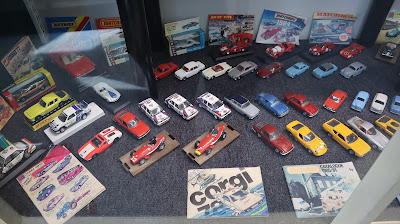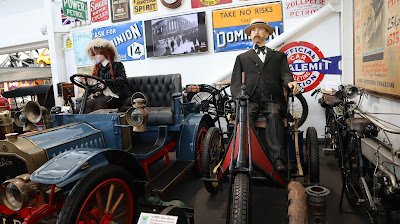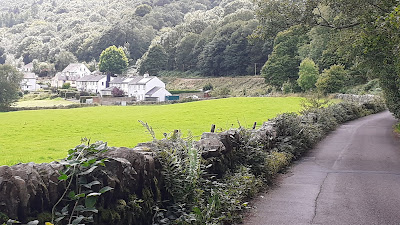It is a Tuesday, but it could be any day of the week. It is September, but it could be any month of the year. It is raining. My walk is cancelled. Despite being told that walking in the rain is good for me, I've decided to give it up. I'm getting too old for weary, arthritic joints. I shall replace it with the 'attraction lottery'. Out comes my old shoebox in which are lots of small pieces of paper, each with the name of an attraction on them. All I have to do is close my eyes, dip my hand in the box, and draw one out. The prize for the winning attraction is a visit from me. Lucky attraction!!
And the winner
is..........The Lakeland Motor Museum. For those that have never
heard of the Lakeland Motor Museum, it is situated in what was the
packaging department of the old "Dolly Blue" works, a
converted mill beside the River Leven at Backbarrow, close to the
main A590 M6 to Barrow road. However, it was originally situated at
Holker Hall, a few miles away on the Cartmel peninsular. It moved to
Backbarrow in 2010, presumably because of lack of space at the old
site.
Now, I have to confess that I wasn't exactly overjoyed at the result of my 'attraction lottery' selection. I am not a big fan of motor museums. Rather like a supermarket car park on a Friday afternoon, they tend to be full of cars! That might sound a tad obvious, so allow me to explain. I once went to a moderately large motor museum in the south of the country. It had very few vintage cars, most on display were from the fifties onwards. They were lined up very nicely, lovingly polished with well written labels telling their story, but they were all locked, and the whole place reminded me of nothing more than a rather posh retro car park. My interest in cars is purely practical, and well set out as it was, the seemingly never ending lines of shiny cars was never going to light my fires of excitement. That having been said, I do remember that some of those visiting (mainly the men!) were getting very excited about each one, and stood around in small groups discussing how they'd love to strip them down and service all moving parts. I overheard one very bored looking lady telling her equally weary female companion that, given the choice of sleeping with her, or a 1930's Buick with double over head camshaft, her husband would probably choose the car.
With this memory etched in my mind, I approached the entrance to the museum with a certain degree of trepidation. The lady behind the counter in the foyer, which doubles as a gift shop, tried to put me at ease, explaining that the exhibitions were smaller but much more diverse than some of the better known motor museums. In particular, she pointed out that there was a section devoted to the history of the building in which the museum is housed. Even so, as I stepped into the main display hall, I was not convinced.
 |
| The museum is not large, although this is only a small part of it. |
She was not wrong about it being smaller. I didn't count the number of vehicles in the collection, but I wouldn't have thought it to be more than 150. So, what else could I expect to see for my entrance fee? There must be something else, as according to the advertising blurb the museum has over 30,000 exhibits. The answer surprised me somewhat.
 |
| There are several displays of toy cars |
I had fully expected to see a display of toy cars, and the small mock up of a garage with a mechanic fiddling about with something he'd disconnected from an engine certainly did not come as a surprise. But a 1960's ladies fashion display? That was unexpected. I discovered it when I spotted a group of four women looking into what appeared to be a mock up of a shop window. Whilst their menfolk were drooling lovingly over a Jaguar XK140 Fixed Head Coupe, the rare one with bespoked wheels, and, very possibly (according to one of the men) a left handed sprockle holder, their ladies were getting equally excited by the flowing lines of a fashionable 1960's ladies dress with full matching accessories. It seemed to me that here was the major difference between men and women. One forever dreaming of some highly desirable object that would forever be out of their reach, whilst the other was full of admiration for something that was not only undeniably beautiful, but also eminently practical. I'll leave you to decide which was which.
 |
| 1956 BSA Motorbike and Sidecar |
In addition to the four wheeled road vehicles, there is also a display of cycles, both pedal and motor, including a motorbike and sidecar not dissimilar to the one my father bought in the early sixties in the days before our family could afford a car.
 |
| I want one of those! |
One of the most charming collections features children's pedal cars. I always wanted one as a child, but my parents decided that, as we lived on a hill (well, more of a slope really) I might lose control of it and crash into our next door neighbour's new and very shiny Ford Consul.
 |
| 1950's motor mechanic, surrounded by 'memorabilia'. |
The museum also has a large collection of what the blurb calls 'memorabilia', although I have to confess that I have never truly understood the true meaning of the word. I mean, an object that is part of a collection because it is connected with something that is thought to be very interesting, could either qualify or not, depending upon your level of interest. Is a petrol pump interesting? Or an old oil can? What about a trolley jack?
 |
| Local history - one of the many display boards for the 'Dolly Blue' works. |
Forgive me, I'm being unnecessarily picky. The point is that the Lakeland Motor Museum actually demonstrates the advantage of my 'Attraction Lottery'. Left to my own devices I would not have visited this place in a million years. As I said before, I don't really like Motor Museums. Or rather, I didn't. It has won me over. It is not just cars. The displays cover almost every aspect of private transport, and more besides. In addition, the local history collections are really well presented, and the period shopping displays are wonderful to browse around.
 |
| Off on holiday circa 1962. In the background, ladies fashionware shop fronts. |
I even had some fun playing on the 1950's slot machines on the small upper floor. There are only four, but they took me back to happy childhood seaside holidays, as did the Austin A35 parked in a corner with a load of 1960's style luggage on the top. I can remember my father hiring one just like it, loading all our luggage onto the roof rack, squeezing the family inside, and driving us down to Devon for a family caravan holiday. When we got there, the people in the next caravan had exactly the same model, except theirs was blue. Ahhh the memories came flooding back.
 |
| Replica of Donald Campbell's1967 jet hydroplane Bluebird K7 |
In a separate building
was another display that brought back childhood memories, although
not as happy. The Campbell Bluebird Exhibition celebrates the
achievements of Sir Malcolm and Donald Campbell. It contains full
sized replicas of Malcolm Campbell's 1935 Blue Bird car, a 1939 Blue
Bird Boat K4 and the 1967 jet hydroplane Bluebird K7. At the tender
age of 12, I well remember watching the harrowing news footage of
Donald Campbell's boat overturning on Coniston Water in January 1967.
I also remember how shocked and saddened the whole nation was at this
tragic accident. Times change. National heroes like Donald Campbell
no longer exist. They've been replaced by reality TV stars.
 |
| Part of the Isle of Man TT races display |
The only part of the museum that did not really
float my boat was the section dealing with the history of the Isle of
Man TT races. However, plenty of people seemed to be watching the
various video displays and reading the timeline tracing the evolution
of the races and the machines that took part in them. I suppose that
sums up the key to museums. You are interested because you either
like and relate to what is on display, or not. And I've never been a biker.
 |
| Looking across the main display space. |
Generally, I enjoyed the Lakeland Motor Museum because of the variety of the exhibits on offer. The local history section was fascinating, especially as, on my walk from the railway station earlier in the day, I had passed the remains of the sites that were featured in the exhibition. Doing so helped to bring the history alive. The shop front displays were interesting not only for their content, but also because I remember shop fronts actually looking like that in the days before out of town shopping centres relegated our high streets to parades of empty shop units with boarded up windows.
 |
| 1962 Austin A40 - standing in front of a small display of 'Bubble Cars'. |
As for the motors on display, well nice as the rarer exhibits were (and there are plenty of them) it was a couple of the more ordinary exhibits that appealed the most. The basic cars that for many families would have been their first experience of actually owning a vehicle of their own, brought back fond memories of an age that has been lost forever.
 | ||
| Wonderful item of Automata, just put 50p in the slot and watch the Amazing Flying Car work. |
 |
| Early motoring in style |
Next door to the museum is Cafe Ambio, which rather conveniently has both indoor and outdoor seating. As luck would have it, by the time I had wandered around the museum, played on the arcade machines, fed the Automata (see pic above) with several 50p's and watched the video presentation regarding Donald Campbell, it had stopped raining. The dark clouds were scuttling away into the distance, revealing a clear blue sky. Enjoying a simple, if rather late lunch of some yummy sandwiches followed by equally gorgeous no calorie cake (who am I kidding!) whilst seated outdoors on a balcony overlooking the River Leven was utter bliss.
A distant train whistle, followed a minute later by the tell tale trail of steam behind the houses on the far side of the river completed the scene. It was also a reminder that this idyllic spot was once a heavily industrialised area. Not only was there the old 'Dolly Blue' works, but a quarter of a mile down the river stood Backbarrow Ironworks, and, a little further still, the Low Wood gunpowder works. All used the river to power their factories, and the railway as a means by which the products they made were exported to the rest of the country, and beyond. An hour before I had my lunch, I had studied the museum displays about the local history, and sitting there beside the river looking out across the valley I imagined what it must have been like on the day I was born, back in the 1950's. A hive of activity, with the good folk of Backbarrow earning their livings creating products that existed in my home, 250 miles away, when I was a child.
Nowadays, the A590 road allows us to speed past the village without
giving it a second thought. Because it is screened by trees, the section
of the village beside the river is barely visible from the main road.
It could have been swept away by modern developers, the past
erased permanently from the landscape. But it hasn't been. The remains of the ironworks are currently being restored. The old Ultramarine works is now the Whitewater Hotel, and has displays about the building's previous use on the lower floor. And the Lakeland Motor Museum not only preserves the history of motoring, but also educates the modern generation about the heritage of the Leven Valley. That is what sets it apart from other motor museums. It is quite unique and very, very special.
My day had begun with a feeling of trepidation. It ended with a sense that I had learned a great deal about an area I mistakenly thought I already had a good knowledge of. The Lakeland Motor Museum was certainly much much more than simply a glorified indoor car park. It turned out to be a treasure trove of surprises.
And now the technical stuff
According to their website (www.lakelandmotormuseum.co.uk) a visit usually takes about 90 minutes, although of course this varies upon your level of interest. My visit took well over 2 hours, and that was not counting my time in the cafe. It cost me £12, but if you are a local resident you can get a discount, (see their website for details).
All the staff were really helpful, which is not always the case everywhere I go.
How I got there
My journey was a circular one. Starting from Ambleside I took a 599 bus to Bowness Pier, then a cruise down the lake (The Yellow Cruise) to Lakeside. After a steam train ride to Haverthwaite I unfurled my umbrella to walk the final mile from Haverthwaite Station. The advantage with this route is that some of the places you pass on the walk are featured in the museum. After my visit I walked the short distance to the A590, to get the bus (Stagecoach no.6) back to Windermere, and then the 599 or 555 to Ambleside. Being of a certain age (70) the buses are free, and I have a yearly pass for the boat (A Christmas pressie, so that was free!). Consequently, I got there for the cost of the train ride.
How you should (probably) get there
Sensible people will simply go by car. The museum is well signposted on the A590, about 2 miles west of Newby Bridge, and has a large, free, car park. Post code for museum and car park is LA12 8T. The museum is open everyday except Christmas Day. 9:30am – 5:30pm April to 1st November, 9:30am – 4:30pm at all other times.







































